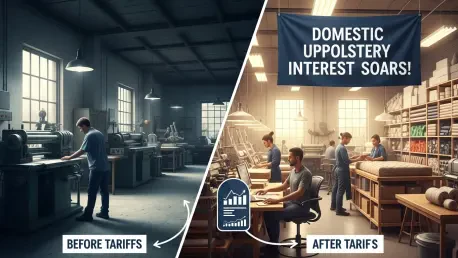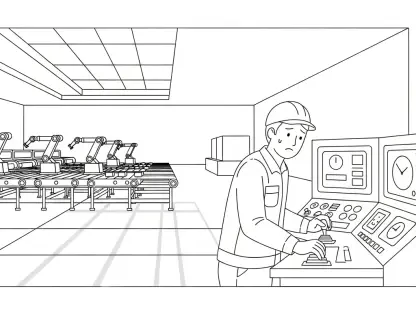In the ever-evolving landscape of the furniture industry, a significant transformation is underway as tariffs on imported upholstery products reshape market dynamics across the United States, sparking renewed focus on domestic manufacturers. Recently introduced Section 232 tariffs, starting at a substantial 25% and slated to climb to 30% in the near future, have created ripples felt strongly at events like the October High Point Market. This major industry gathering revealed a surge in showroom traffic as retailers, eager to sidestep the rising costs of imported goods, turned their attention to American-made options. The impact of these tariffs extends beyond mere pricing, touching on aspects of innovation, customization, and strategic adaptation that are redefining how retailers approach their sourcing decisions. What makes this shift particularly compelling is the way it highlights the inherent strengths of domestic producers, who are seizing the moment to showcase their agility and responsiveness to market needs. This article delves into the multifaceted effects of these tariffs, exploring how they are driving interest in U.S.-based upholstery manufacturers. From sofas to loveseats, the conversation is shifting, with cost advantages blending seamlessly with operational benefits to create a compelling case for local production. As the industry navigates this pivotal moment, understanding the broader implications of these changes becomes essential for grasping the future direction of furniture retail.
The Pricing Edge and Market Shifts
The imposition of tariffs on imported upholstery has handed domestic manufacturers a tangible competitive advantage, particularly in key product categories such as sofas and loveseats. With the current tariff rate providing a 10-11% pricing edge over imports from countries like Vietnam, Malaysia, and Thailand, U.S. producers are finding themselves in a favorable position. This advantage was vividly on display at the High Point Market, where showroom floors buzzed with increased foot traffic from retailers actively seeking alternatives to the now costlier imported options. The financial incentive created by these tariffs is not merely a numbers game; it represents a shift in how sourcing decisions are made, with cost considerations prompting a reevaluation of long-standing reliance on overseas suppliers. While the upcoming increase in tariff rates promises to widen this gap further, the immediate effect has already set the stage for domestic producers to capture a larger share of retailer interest. This pricing dynamic is a critical driver, pushing buyers to explore local options that were previously overshadowed by the lower upfront costs of imports, and it signals a potential long-term realignment in the market.
Despite the evident spike in showroom activity, this heightened interest has not always translated into a flood of immediate orders for domestic upholstery manufacturers. Retailers appear to be adopting a cautious stance, prioritizing relationship-building and product exploration over hasty commitments. Conversations at the High Point Market often centered on future possibilities rather than on-the-spot purchases, reflecting a broader wait-and-see approach within the industry. This hesitancy suggests that while the tariff-induced pricing edge is a powerful motivator, other factors such as trust in consistent supply and alignment with consumer trends are equally important in sealing deals. Manufacturers are finding that their role extends beyond offering competitive prices to demonstrating reliability and adaptability in a market still adjusting to these policy changes. This dynamic underscores the complexity of translating interest into tangible business outcomes, as retailers balance the allure of cost savings with the practicalities of shifting supply chains in a landscape marked by evolving tariff structures.
Operational Strengths of Domestic Producers
One of the standout advantages for domestic upholstery manufacturers lies in their ability to offer significantly shorter lead times compared to their international counterparts. Companies are capitalizing on this strength, with some, like Norwalk Furniture, promising delivery of custom orders within an impressive 35-day window. This rapid turnaround stands in sharp contrast to the often prolonged waiting periods associated with imported goods, which can be delayed by logistical challenges across oceans. For retailers, this speed translates into the ability to maintain leaner inventories, reducing the risk of overstock that plagued many during past supply chain disruptions. The agility of domestic production not only addresses immediate needs but also provides a buffer against the unpredictability of global shipping, making it an appealing option for businesses looking to streamline operations. This operational efficiency is proving to be a cornerstone in the renewed interest from buyers who value responsiveness as much as cost, highlighting how domestic producers are well-positioned to meet the demands of a fast-paced retail environment.
Another pivotal factor fueling retailer enthusiasm is the robust customization capabilities offered by U.S.-based manufacturers. Firms like Bassett Furniture are tapping into a growing consumer desire for personalized furniture, offering tailored options in fabrics, finishes, and designs that break away from the monotony of mass-produced imports. This ability to cater to individual preferences is resonating strongly in a market increasingly driven by the demand for unique, standout pieces that reflect personal style. Unlike the standardized offerings often associated with overseas production, domestic producers can pivot quickly to meet specific retailer needs, ensuring that inventory aligns closely with current trends and customer expectations. This customization edge not only enhances product appeal but also helps retailers differentiate themselves in a competitive space, avoiding the oversaturation of generic designs. As a result, the flexibility inherent in domestic production is emerging as a key differentiator, solidifying its role in capturing the attention of buyers navigating the challenges posed by tariff-driven cost increases.
Innovation and Market Appeal
At the heart of the domestic upholstery resurgence is a wave of innovation that goes beyond mere pricing advantages, as manufacturers unveil fresh designs to captivate retailer interest. During the High Point Market, companies like Southern Motion introduced new frames paired with trending color palettes such as greens and blues, moving away from traditional neutral tones. Similarly, Best Home Furnishings rolled out a vibrant licensed collection that embraced bold patterns and lively hues, signaling a shift toward more dynamic aesthetics. These product launches are strategically designed to align with evolving consumer tastes, offering retailers marketable options that stand out on showroom floors. The focus on refreshing product lines demonstrates a proactive approach among domestic producers, who recognize that capturing market share requires more than cost benefits—it demands relevance and appeal. By prioritizing design innovation, these manufacturers are ensuring that their offerings resonate with a retail audience eager for novelty, thereby strengthening their position in a tariff-influenced landscape.
Beyond new designs, domestic manufacturers are also adapting to consumer preferences through strategic curation of materials and product offerings. Facing tariff hikes on imported components like Chinese fabrics, companies such as Bassett Furniture have streamlined their fabric grades to maintain affordability without sacrificing quality. This adaptability reflects a keen understanding of market needs, ensuring that products remain competitive even as external costs rise. Additionally, the emphasis on aligning with current style trends—whether through nostalgic collections or modern color schemes—shows a commitment to staying ahead of the curve. Retailers benefit from this responsiveness, as it allows them to stock items that are more likely to attract buyers seeking the latest in home decor. This focus on meeting consumer demand through thoughtful product adjustments highlights how domestic producers are not just reacting to tariffs but actively shaping their market presence through innovation, reinforcing their appeal to a discerning retail base.
Navigating Import Challenges
While tariffs on imported upholstery have undeniably shifted the cost equation, they are far from the only challenge complicating overseas sourcing for retailers. Logistical hurdles such as delays tied to events like Chinese New Year, persistent container shortages, and unexpected customs holdups introduce significant uncertainty into the supply chain. Industry leaders, including voices from RW Collective, have pointed out that these unpredictable factors often outweigh tariff costs in their impact on business planning. For retailers, the inability to accurately forecast delivery timelines creates a ripple effect, disrupting inventory management and sales strategies. In contrast, domestic production offers a level of predictability and control that is increasingly valued in a market prone to such disruptions. This reliability factor is becoming a compelling reason for buyers to reconsider their sourcing priorities, as the hidden costs of import delays reveal themselves to be just as burdensome as the financial levies imposed by tariffs.
The compounded challenges of importing extend to the broader operational risks that retailers must navigate when dealing with international suppliers. Beyond the logistical snags, issues like forecasting inaccuracies can lead to either stock shortages or costly overages, both of which strain financial resources. The contrast with domestic manufacturers, who can adjust production more swiftly to match demand, becomes starkly apparent in this context. Retailers are beginning to recognize that the apparent savings from lower import prices are often eroded by these ancillary complications, making the case for local sourcing more persuasive. This growing awareness is contributing to the shift in interest toward U.S.-based producers, as the industry grapples with a supply chain environment that remains volatile. The tariff landscape may be the catalyst, but it is these underlying operational concerns that are sustaining the momentum for domestic upholstery as a more stable and strategic choice for many businesses.
Strategic Responses and Market Variations
In response to the growing interest spurred by tariffs, domestic upholstery manufacturers are making bold strategic moves to solidify their market position through investments in growth and technology. Companies like RW Collective are expanding production lines to accommodate anticipated demand, ensuring they can scale up without sacrificing speed or quality. Meanwhile, Best Home Furnishings has invested in advanced fabric-cutting machinery to enhance efficiency and maintain competitive lead times. These initiatives reflect a forward-thinking mindset among producers, who are not content to rest on the laurels of tariff advantages but are instead preparing for sustained retailer engagement. Such investments signal confidence in the long-term viability of domestic sourcing as a key component of the furniture supply chain. By bolstering capacity and embracing technological advancements, these manufacturers are positioning themselves as reliable partners for retailers navigating the uncertainties of global trade policies, thereby deepening the trust and interest from their buyer base.
The impact of tariffs on domestic upholstery interest also varies significantly across different price points and market segments, revealing the nuanced nature of the industry’s response. Mid-priced brands like Albany Industries and Southern Motion are experiencing a more pronounced uptick in retailer attention, as the narrowing cost gap with imports makes their offerings particularly attractive to value-conscious buyers. Conversely, high-end manufacturers such as Rock House Designer Brands report that their clientele—often designers and luxury retailers—remains largely unaffected by tariff discussions, given their existing focus on bespoke, domestically produced pieces. This disparity underscores the complexity of the market, where tariff effects are filtered through the lens of consumer demographics and pricing strategies. While mid-range producers capitalize on cost-driven interest, luxury segments continue to thrive on quality and customization, illustrating how diverse approaches within the domestic upholstery sector are collectively contributing to a broader resurgence fueled by current trade policies.
Looking Back at a Pivotal Shift
Reflecting on the recent developments in the upholstery industry, it became clear that the October High Point Market marked a turning point for domestic manufacturers in the United States. The buzz in showrooms, driven by the pricing edge from Section 232 tariffs, showcased a growing curiosity among retailers who flocked to explore local alternatives. This event captured a snapshot of an industry in transition, where cost advantages intertwined with operational strengths like quick delivery and customization to create a compelling narrative for American-made furniture. Manufacturers across various segments responded with enthusiasm, unveiling innovative designs and reinforcing their commitment to meeting retailer needs through strategic adaptations.
As the dust settled on this pivotal moment, the path forward emerged with actionable insights for domestic producers to sustain this momentum. Continued investment in production capacity and technology stood out as a critical step to handle rising demand without compromising on speed or quality. Additionally, maintaining a sharp focus on product innovation—through trendy designs and tailored offerings—promised to keep retailers engaged in a competitive market. The varying impact across price points also suggested that targeted strategies, whether for mid-range value or high-end luxury, were essential to maximize opportunities. While uncertainties around future tariff adjustments lingered, the adaptability shown by manufacturers at that time laid a strong foundation for navigating whatever challenges lay ahead, ensuring that the interest sparked by these trade policies could evolve into lasting partnerships.









